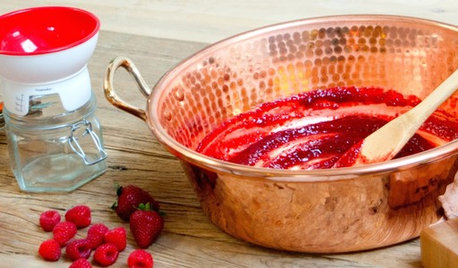drying cherry tomatoes
fearlessem
17 years ago
Related Stories

EDIBLE GARDENSSummer Crops: How to Grow Tomatoes
Plant tomato seedlings in spring for one of the best tastes of summer, fresh from your backyard
Full Story
LIFEKitchen Traditions: Tomato Season Meets a Family Legacy
Somewhere a Sicilian great-great-grandmother is smiling at a bowl of American-made sauce
Full Story
ARCHITECTUREHouzz Tour: Fresh Ideas in a Former Tomato Packing Shed
A formerly metal-clad structure is now a beautiful wood home designed to capture the light and preserve open space
Full Story
EDIBLE GARDENSHow to Grow Your Own Luscious Cherries
Nope, they’re not the easiest fruit to grow. But with spectacular blossoms and pies as possibilities, cherries are sure worth a try
Full Story
GARDENING GUIDESPlant Black Cherry Trees for the Birds and Bees
Plant Prunus serotina in the Central and Eastern U.S. for spring flowers, interesting bark and beautiful fall color
Full Story
SHOP HOUZZHouzz Products: Save a Taste of Summer
Can't bear to part with the flavors of summer peaches, berries and tomatoes? Then jam on it!
Full Story
REMODELING GUIDESYour Floors: Zebra, Tiger, and Teak Wood, Oh, My!
Get the Pros and Cons of Exotic Woods: Hickory, Cherry, Rosewood and More
Full Story
FARM YOUR YARDHouzz Call: Home Farmers, Show Us Your Edible Gardens
We want to see where your tomatoes, summer squashes and beautiful berries are growing this summer
Full Story
HOUZZ TOURSHouzz Tour: Wild for Wood in Central Texas
Mesquite, cherry and white oak harmonize beautifully in an Austin family's warm and modern home
Full Story
GARDENING GUIDESCalifornia Gardener's June Checklist
Update your hydrangeas, catch up on tomatoes and more ways to enjoy your California garden in June
Full Story





prairie_love
bitterwort
Related Professionals
Clark Landscape Architects & Landscape Designers · Cottonwood Landscape Architects & Landscape Designers · Salisbury Landscape Architects & Landscape Designers · West Chester Landscape Architects & Landscape Designers · Camp Verde Landscape Contractors · Chattanooga Landscape Contractors · Hampton Bays Landscape Contractors · Ponte Vedra Beach Landscape Contractors · River Ridge Landscape Contractors · Greenfield Landscape Contractors · Parker Roofing & Gutters · Cincinnati Driveway Installation & Maintenance · Fremont Driveway Installation & Maintenance · Libertyville Driveway Installation & Maintenance · Royal Oak Driveway Installation & Maintenancereadinglady
gardenlad
John__ShowMe__USA
zabby17
ksrogers
jimster
firstthyme
John__ShowMe__USA
david52 Zone 6
zabby17
ksrogers
readinglady
jimster
John__ShowMe__USA
sapman
gardenlad
prairie_love
John__ShowMe__USA
ksrogers
John__ShowMe__USA
gardenlad
jimster
John__ShowMe__USA
gardenlad
buckeyefan
John__ShowMe__USA
ksrogers